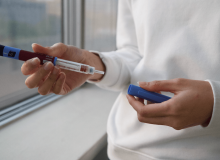Some people with diabetes said, "It doesn't seem to matter if you have diabetes. It's not painful or itchy, but your blood sugar is a little high." Some people with diabetes also said, "I test my blood sugar once a week, and I feel that it's under pretty good control." About these statements , what do you think?
In fact, our body is the most honest, and many conditions can reflect how well our blood sugar is controlled. If you don’t know whether your blood sugar is well controlled or are worried about whether you are prone to complications, first check to see if you can. What will be the following performances?
1. Blurred vision
"I always feel like there is a layer of fog in front of my eyes, and I can't see clearly." "I heard someone saying hello to me from a distance, but I couldn't see who it was. It was so embarrassing. I felt like my eyes were really dim."
This is a common problem for people with diabetes who have vision problems.
Of course, lack of sleep or overuse of the eyes can lead to blurred vision, but in addition to these factors, there is also blurred vision, which is getting worse and worse, which may be caused by diabetic retinopathy, and the longer the course of the disease, the more severe the condition. The higher the probability.
Therefore, whether you have such a situation or not, it is recommended that people with diabetes go to the hospital’s ophthalmology department for a fundus review every six months.
2. A lot of foam in urine
If a diabetic patient has excessive foamy urine, it is mostly caused by proteinuria and may indicate damage to kidney function.
Proteinuria is a clinical sign of diabetic nephropathy, and glomerulosclerosis in diabetic patients is often accompanied by proteinuria. Therefore, diabetic patients should regularly review urine protein.
3. Edema
Another very important manifestation of diabetic nephropathy is edema. What is edema? Some people think that I am fat because of edema, but this is not the case.
How to judge whether you have edema? Use your fingers to press your legs. If the meat still dents instead of rebounding after you remove your fingers, then you have edema.
4. “I feel like my body has been hollowed out”
Some people with diabetes said that they have been suffering from high blood sugar for a year or two. Although there are no obvious physical problems, they feel inexplicably weak and tired, and they are unable to do anything they do.
People with type 2 diabetes often experience this situation, which really has a great impact on the quality of life. After controlling blood sugar, they find that the fatigue that has always existed is gone and their mental state is much better.
More severe cases are accompanied by nausea and vomiting, which may be ketoacidosis caused by obstruction of glucose circulation in the body and poor blood sugar control. Young patients with type 1 diabetes, especially those with long-term poor blood sugar control, need to pay attention.
5. Feeling like there are ants crawling on you
This numbness slowly progresses from the distal ends of the limbs. Sometimes it feels like ants crawling, needles pricking, or something burning. This may indicate the occurrence of a complication - diabetic peripheral neuropathy.
It is common in the long course of diabetes and poor blood sugar control, resulting in the symptoms of numbness in the hands and feet. The symptoms gradually progress from mild to severe.
In the advanced stage, there may be complete loss of pain, temperature and touch sensations. At this time, the limbs are easily injured due to lack of nerve protection. Many diabetic feet also suffer from scalds and burns due to sensory impairment and are completely unaware of them until they are injured. I only discovered it when it got serious.
Once the nerve is damaged, it is almost irreversible and requires early attention.
6. Cold hands and feet
Cold hands and feet, accompanied by pain in the lower limbs and intermittent claudication (that is, there is no obvious discomfort when not walking, but when walking, the affected lower limbs will feel sore and uncomfortable, so that they have to stop and rest. After a period of rest, this will The discomfort disappears and you can continue walking) It is very likely that you have arteriosclerosis obliterans in the lower limbs.
Diabetes can easily cause or accelerate arteriosclerosis, resulting in combined vascular disease, causing arterial narrowing or blockage.
Generally, diabetic patients with mild stenosis may not feel anything, but severe cases may cause diabetic foot gangrene and even amputation.
7. Blood pressure changes
The three highs and highs are indistinguishable. Most people with diabetes will find that their blood pressure is high when they go for a physical examination. High blood pressure is often a concomitant disease for people with diabetes. Hypertension combined with diabetes will accelerate the development of our heart, brain, kidneys, and fundus. , damage to organs such as large blood vessels.
Therefore, in addition to paying attention to monitoring blood sugar in daily life, we also need to monitor blood pressure.
Clinically, some people with diabetes and hypertension will experience orthostatic hypotension, which manifests as dizziness, palpitation, and darkening of the eyes. This requires attention. Pay attention to whether you go from lying to sitting up, from squatting or sitting. When changing positions from standing up, don't move too quickly to avoid fainting.
Many times, although the fact that we have diabetes cannot be changed, we can control the complications well, which not only improves our quality of life, but also reduces the burden on our families. Indeed, we have diabetes.
Our goal is not only to control blood sugar, but more importantly, to avoid complications and live a healthier and longer life. This is the original intention of every diabetes patient.

